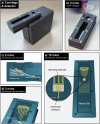A passive blood separation sensing platform for point-of-care devices
- PMID: 40322246
- PMCID: PMC12048346
- DOI: 10.1038/s44328-025-00038-x
A passive blood separation sensing platform for point-of-care devices
Abstract
The blood test is one of the most performed investigations in clinical practice, with samples typically analysed in a centralised laboratory. Many of these tests monitor routine conditions that would benefit from a point-of-care approach, reducing the burden on practitioners, patients and healthcare systems. Such a decentralised model requires the development of sophisticated, yet easy-to-use technology; however, platforms that combine high-performance with low-cost and simplicity remain scarce. Moreover, most research papers only address a subset of requirements and study specific aspects in isolation. A systems approach that considers the interplay between each element of the technology is clearly required to develop a coherent solution. Here, we present such a systems approach in the context of testing for C-reactive protein (CRP), a commonly requested test in clinical practise that indicates inflammation and is particularly relevant for monitoring patients with chronic diseases, e.g. those with rheumatoid arthritis or who are undergoing cancer therapy. The approach we take here features an entirely passive microfluidic cartridge for blood separation, integrated with a high-performance sensing platform which we have tested in a real-world context. The device is compatible with a handheld detection unit and is simple to use yet can accurately detect CRP levels at clinically relevant levels.
Keywords: Applied optics; Biomedical engineering; Diagnostic markers; Lab-on-a-chip; Nanobiotechnology; Sensors and probes.
© The Author(s) 2025.
Conflict of interest statement
Competing interestsThe authors declare no competing interests.
Figures






Similar articles
-
[Standard technical specifications for methacholine chloride (Methacholine) bronchial challenge test (2023)].Zhonghua Jie He He Hu Xi Za Zhi. 2024 Feb 12;47(2):101-119. doi: 10.3760/cma.j.cn112147-20231019-00247. Zhonghua Jie He He Hu Xi Za Zhi. 2024. PMID: 38309959 Chinese.
-
Integrated electrochemical microsystems for genetic detection of pathogens at the point of care.Acc Chem Res. 2015 Apr 21;48(4):911-20. doi: 10.1021/ar500456w. Epub 2015 Mar 18. Acc Chem Res. 2015. PMID: 25785632
-
Lab-on-a-Disc for Point-of-Care Infection Diagnostics.Acc Chem Res. 2021 Oct 5;54(19):3643-3655. doi: 10.1021/acs.accounts.1c00367. Epub 2021 Sep 13. Acc Chem Res. 2021. PMID: 34516092
-
Lab-on-fiber technology: a new vision for chemical and biological sensing.Analyst. 2015 Dec 21;140(24):8068-79. doi: 10.1039/c5an01241d. Analyst. 2015. PMID: 26514109 Review.
-
A critical insight into the development pipeline of microfluidic immunoassay devices for the sensitive quantitation of protein biomarkers at the point of care.Analyst. 2017 Mar 13;142(6):858-882. doi: 10.1039/c6an02445a. Analyst. 2017. PMID: 28217778 Review.
References
-
- Future of POC and Rapid Testing. (Ipsos, Sermo).
-
- Kenaan, A. et al. Guided mode resonance sensor for the parallel detection of multiple protein biomarkers in human urine with high sensitivity. Biosens. Bioelectron.153, 112047 (2020). - PubMed
-
- Bakshi, S. et al. Nanophotonic and hydrogel-based diagnostic system for the monitoring of chronic wounds. Biosens. Bioelectron.242, 115743 (2023). - PubMed
LinkOut - more resources
Full Text Sources
Research Materials
Miscellaneous
